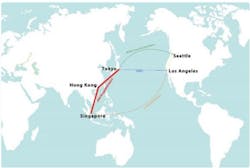Consortium completes 100G international fiber-optic network for research and education in Asia
The National Institute of Information and Communications Technology (NICT) in Japan and the National Supercomputing Centre (NSCC) and Singapore Advanced Research and Education Network (SingAREN) in Singapore have jointly completed a 100G international fiber-optic network to connect Singapore, Hong Kong, and Japan for international research and education networks (RENs) in Asia, the entities have announced.
The infrastructure will be the backbone of a North to South-East Asia network, enabling nodes in Singapore and Japan to be Asia's hubs worldwide for trans-continental research and education connectivity at 100G speeds. With the link, the research and education community will be able to finish the new Asia Pacific Ring (APR) network throughout the Pacific between Asia and North America.
The network will advance high-level research and education, bioinformatics, and supercomputing collaboration, such as partnerships between the NSCC Singapore and Japan's leading research institutions, including Tokyo Institute of Technology (Tokyo Tech), RIKEN, RIST, and JAXA. According to the collaborators, researchers and scientists in Singapore and Japan can efficiently share data and derive research outcomes on weather and climate studies, improved manufacturing and engineering, healthcare and biomedical sciences, robotics and AI, machine-learning, big data analytics, and precision engineering.
The network was supplied by PCCW Global, the international operating division of HKT that took capacity on America Europe Connect (AEConnect), the transatlantic submarine cable, for route diversity last year (see "PCCW Global signs up for AEConnect submarine cable capacity").
The SingAREN and NICT network will use PCCW Global's submarine cable capacity to deliver efficient interconnections and network resilience for several RENs throughout the Pacific. The network is 10 times faster than the region's existing 10G networks, the NICT attests.
For related articles, visit the Network Design Topic Center.
For more information on high-speed transmission systems and suppliers, visit the Lightwave Buyer's Guide.
